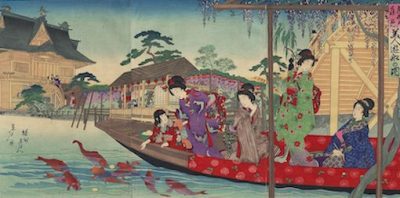Japanese Art and Yoshu Chikanobu (Toyohara Chikanobu)
Lee Jay Walker
Modern Tokyo Times

The Japanese master Yoshu Chikanobu (Toyohara Chikanobu) lived through an age when the old world of Japan was dissolving and a new one was being forged. His lifetime (1838–1912) stretched from the fading incense of the Edo Period to the restless dynamism of the Meiji era—an arc of history that reshaped not only the nation, but the inner landscape of his artistic soul. Inevitably, these seismic shifts seeped into his prints, colouring his vision and sharpening his sensitivity to the changing artistic sands beneath his feet.
Chikanobu’s artistry was remarkably expansive. He could summon the graceful allure of bijin-ga, capturing refined beauty with a whisper of melancholy, yet in the next breath turn to the sensational tides of contemporary news. Nothing was beyond his gaze: gruesome murders that shook the public imagination, historic dramas brought back to life, quiet scenic vistas, and the subtle poetry of evolving fashions. Even the wars and political transformations of the Meiji Period found form within his woodblock prints.

By embracing this wide spectrum—from the elegant to the unsettling—Chikanobu connected with an enormous audience. He embodied the vibrant spirit of ukiyo-e at a moment when the floating world itself was transforming, ensuring that his art resonated deeply with those who sought beauty, immediacy, and reflection amid the currents of a rapidly changing Japan.
The Morikami Museum says, “Yōshū Chikanobu was one of the last great ukiyo-e print designers. He produced images of the kabuki stage, beautiful women (bijin-ga), and historical and legendary events. Chikanobu also illustrated murders and other sensational news of the day and chronicled the modernization of Japanese society in the late 19th century.”

Chikanobu understood with remarkable clarity that the artistic sands beneath Japan were shifting. As the Meiji leadership turned its gaze toward Western aesthetics—eager to mirror the modernity of distant nations—he sensed the quiet peril this posed to traditional forms. Yet rather than retreat, Chikanobu transformed. He reshaped his ukiyo-e with a subtle, deft hand, allowing it to breathe within the new age while still retaining the soul of the old.
In doing so, he demonstrated not only adaptability but artistic fidelity. Chikanobu re-engaged with a changing market, embracing new themes, new sensibilities, and the restless tempo of Meiji modernity. And yet, at his core, he remained unwaveringly loyal to the craft of printmaking—ensuring that ukiyo-e would continue to whisper its timeless beauty even as Japan stepped boldly into a different world.

Modern Tokyo News is part of the Modern Tokyo Times group
http://moderntokyotimes.com Modern Tokyo Times – International News and Japan News
http://sawakoart.com – Sawako Utsumi and her website – Modern Tokyo Times artist
https://moderntokyonews.com Modern Tokyo News – Tokyo News and International News
PLEASE JOIN ON TWITTER
https://twitter.com/MTT_News Modern Tokyo Times
PLEASE JOIN ON FACEBOOK